Vol 5 No. 9 TROPIC LIGHTNING NEWS March 2, 1970
Index
A Flying Mess
Concrete Problem Solved With Mixups
By 1LT ROBERT E. GOLDEN
TAY NINH - It doesn't take much in the way of planning, coordination or
effort to burn down the mess hall on the top of Nui Ba Den, but try and rebuild
that chow hall and you'll see it ain't quite so simple.
For the men of the 507th Engineer Detachment (based in Long Binh, but
temporarily working out of Tay Ninh Base Camp), it was a unique challenge to
their logistical ability and mental ingenuity. There was never really any doubt
that they could do it.
It all started a few weeks ago when the mess hall atop the Black Virgin
Mountain burned to the ground. Pacific Architects and Engineers didn't have the
capability to build it. The 507th did and they promptly volunteered for the
job.
The biggest problem was how to haul 36 cubic yards of concrete up there for
the mess hall's floor. "We thought about it for a while," recalled First
Lieutenant Robert B. Gordon of Anapolis, Md., "and decided it wouldn't be
feasible to haul all the raw materials up there and mix the cement on the top.
It was more practical and a lot faster to do the mixing here and then haul the
mixed concrete up there."
So that's what they did. They set out procuring two cement buckets, 240 bags
of cement, 12 cubic yards of sand, 24 cubic yards of crushed rock and 1,800
gallons of water plus the cement mixer.
The only way to get the stuff up there was to hook the buckets on the south
end of a Chinook sling. After two days of bucket shuttling and 18 blade hours,
the engineers had hauled 145,800 pounds of concrete to the 3,200 foot summit of
Nui Ba Den.
That task completed, the engineer platoon got busily to work building the
rest of the mess facility.
Gordon estimated the job would take about 10 days. Fortunately, the 1st
Brigade troops stationed on the mountain didn't have to eat "Cs" all that time.
They got their hot meals in a makeshift mountain-expedient mess hall, but they
were very grateful to the engineers for their interest, ability and efficiency
in rebuilding their much-missed mess hall.
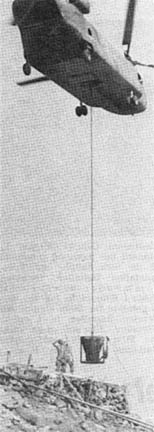 |
TOP OF THE ROCK - A load of cement, mixed at Tay Ninh Base Camp is lowered to a work area atop Nui Ba Den for the concrete floor of a new mess hall. It took 36 bucket-loads to do the job. (Photo by 1LT Robert E. Golden) |
Triple Deuce, Triple Cache
Friday 13th Unlucky Only for Charlie
By SP4 DENNIS J. BRIES
PB DIXON - The Triple Deuce soldiers were a little wary of searching the
heavily booby trapped area - especially since it was Friday the 13th. But as it
turned out, only the VC were unlucky - losing two large munitions caches and a
haul of medical supplies.
Men of the 3d Platoon of Charlie Company, 2d Battalion (Mech), 22d Infantry,
found the caches in a 200 meter triangle about four miles from Patrol Base Dixon
during a detailed sweep of the area. The caches were found after bamboo and
weeds had been burned off the day before.
After destroying several booby traps in place, the men moved into a hedgerow
which had been burned off. One hole in the hedgerow prompted the men to stop
and look it over.
A cooking pot and pieces of pottery nearby led Specialist 4 Fernando
Martinez, Burley, Idaho, to a hole with bamboo cover that had been partially
exposed by the fire. The first cache contained about 1,000 AK rounds, 59 B40
rockets with 50 boosters, 25 rifle grenades, 2,000 feet of wire, two wire
cutters, two AK magazines, five booby traps, three 20 pound anti-tank mines and
three Chicom claymores.
About 50 meters from the first munitions cache, numerous empty medicine
bottles, vials and documents were found.
By this time Specialist 4 James S. Engram, Fitzpatrick, Ala., Private First
Class Harvy D. Rogers, Long Beach, Calif., Specialist 4 Clifton Mack, Oklahoma
City, and other members of their squad had moved to another hedgerow where a
third cache was uncovered. This time the haul included 357 grenade type booby
traps and one 82mm mortar round.
Other finds in the area that day included more documents, notebooks and a
damaged AK rifle. Several days earlier other members of Charlie Company had
found 50,000 piasters and numerous documents in the same area.
ADC Gives Hurt ARVNs Gift Packages
By SP5 DANLEY E. DELANEY
TAY NINH - Brigadier General Michael J. L. Greene, assistant division
commander, handed out 290 gift packages to wounded soldiers at the ARVN military
hospital at Tay Ninh the day before TET.
The general was assisted by Colonel Paul E. Mueller, First Brigade commanding
officer, and members of the hospital staff, including several pretty Vietnamese
nurses.
The entire 1st Brigade S-5 staff spent more than four hours preparing more
than 350 decorated red cellophane gift parcels.
Girl And Claymore Are in Same Bag
By SGT. BILL OBERHOLZER
TAY NINH - Claymore mines really pack a punch, especially those made by the
Hercules Powder Company in New York City. A Platoon of HHC 4th battalion (Mech)
23rd infantry discovered this fact one day.
Staff Sergeant Alan Richey of Marian, Ind., was opening a claymore bag to
check out the newly arrived munition when a note fell out.
"I didn't think much of it at first," replied Richey. "But when I read the
note I couldn't wait to tell the fellows."
It seems an eligible young female from the Hercules Powder Company, by the
name of Sally Mofett, had inserted her name and address into the bag. A letter
was composed by several members of the platoon and it was immediately sent to
her to see if any more correspondence would come from the hopefully fair young
maiden in the "world."
Sergeant Clyde Sparks of Temple, Texas received her next letter. "She told
us that she worked on an assembly line for the Company," replied Sparks. "She
also told us about some of her co-workers, and a most interesting fact which she
included was her measurements. (36-24-36)."
Specialist 4 Ed Kirkland of Sanford, Fla. added, "She called the platoon her
platoon and was very anxious to get a picture of all of us."
Correspondence continues as the fellows are planning to send a picture when
they can get the entire platoon together. Captain Robert Renneisen, the company
commander, got into the act by sending her a certificate of appreciation making
her an honorary member of the Tomahawk Battalion.
| GENTLY, GENTLY - Specialist 4 Clifton Mac of Oklahoma City, gently sets down one of 357 grenades handed him by Private First Class Harvy D. Rogers of Long Beach, Calif. The cache was found during ground operations by 3d Platoon, Charlie Company, Triple Deuce. (Photo by SP4 Dennis J. Bries) |
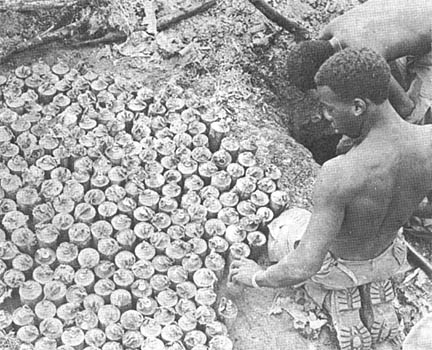 |
Page 2 TROPIC LIGHTNING NEWS March 2, 1970
Decorated
| BRONZE STAR FOR HEROISM | |
|
CPT Leland W. Potter Jr., Co C, 2d Bn, 22 Inf |
SP4 Guy W. Taylor, Co C, 4th Bn (M), 23 Inf |
VHF Replaces Mobile Stations
FSB's Receive Better MARS Services
By SP4 R. J. DOMBROWIECKI
Thanks to a new concept in communications, the Military Affiliate Radio
System (MARS) is now making it easier for fire support base personnel to call
home more often.
This new service is made possible by direct radio contact between the Cu Chi
MARS station and VHF operators at support bases.
"It's a lot easier this way instead of having to lug our equipment out to
each support base as before," said Staff Sergeant Bob Cooley, NCOIC of the Cu
Chi station. Time lost in transporting, setting up, dismantling and maintaining
the equipment has been eliminated. The time saved now allows more support bases
to participate in the MARS service.
"We're the first MARS station in Vietnam to operate this way," added Cooley,
of Portland, Ore., "and it's been very successful."
In commenting on the effectiveness of the MARS system, the sergeant said,
"Callers usually reach their party ninety per cent of the time, but due to the
many requests for calls we must limit the connection to three minutes."
The sergeant offered these tips to make calling easier:
1) Make sure the number being called is complete and correct, including
the area code;
2) If possible, include an alternate number in case your first party
cannot be reached;
3) Know what you want to say before making the call;
4) When speaking, try to disregard background static and concentrate on
your party's voice.
Support base personnel can make calls usually between 7 a.m. and 11:30 a.m.
Afternoon calling is available through Hawaii, but at a considerably greater
cost to your party. Personnel wishing to make a call should contact their
signal officer or VHF radio operator as far in advance as possible.
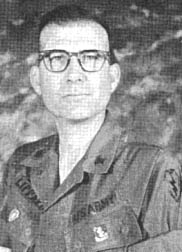 |
Lieutenant Colonel Dlemas V. Lippard has assumed command of the 25th Supply and Transportation Battalion. Outgoing commander was Lieutenant Colonel William R. Strong, who is going to the 308th Supply and Service Battalion in Giesseni Germany. Lippard came from the 541st Supply and Service Battalion at Ft. Riley, Kan. |
Councils Discuss Safety
CU CHI - A new program to cover all facets of safety has recently been
initiated in the 3d Brigade, 25th Infantry Division.
"There hasn't been a trend toward more accidents, but we are using this as a
preventive measure," said Lieutenant Colonel William Martin, the brigade's
executive officer. Martin is in charge of the program.
With the motto; "Double check safety and fight," the goal of the project is
to have zero accidents in 1970.
"People say you're bound to have accidents. We feel that is the wrong
attitude. We think you're bound not to have accidents," Martin said.
In order to discuss safety problems, company safety councils will be
operating throughout the brigade. The councils will make recommendations and
point out areas where a stronger emphasis is needed to protect soldiers from
unnecessary danger.
Vehicle operators will be reviewed and given lectures urging them to drive
more defensively.
"Even if you obey all the traffic rules you can still have an accident if you
don't watch out for the other guy," said Martin.
Weapon safety is another area where precaution will be stressed. Classes for
the proper care and handling for all firearms from the largest artillery piece
to pistols will be conducted periodically. There will also be new regulations
covering personal weapons and war trophies.
"We want to point out that the same safety rules for weapons used in the
States also apply here," Martin said.
Under the new policy, in all areas where safety is needed there will be
constant reminders to urge soldiers to be careful.
Now You See It, Now You Don't
By SGT. K. C. CULLEN
TAY NINH - Disappearing pointmen would give any squad leader a headache.
When Sergeant Richard Hawkins of West Allis, Wise., glanced ahead and saw that
his pointman had vanished he thought he was seeing things.
The Regulars of Alfa Company, 3d Battalion, 22d Infantry, were on an Eagle
Eye Mission northwest of Tay Ninh City when the choppers set them down near a
woodline.
Private First Class James Hargadon of New York City was the point man in
Hawkins' squad - at least to start out.
"I was looking to the flank," said SGT Hawkins. "When I looked forward, I
was the pointman. Jim had disappeared."
The problem was quickly discovered as Hawkins moved forward. He found his
lead man at the bottom of a 9-foot well.
Hardagon was quickly extricated from his narrow trap by the rest of his
squad.
"The worst damage was to my ego," said the embarrassed PFC. "I should have
seen the thing before I fell in."
TROPIC LIGHTNING
Combat Honor Roll
Sergeant Victor Monis has been added to the Tropic Lightning Combat Honor
Roll.
Monis was cited for his heroic actions on Jan. 11, 1970, while serving as a
squad leader with Company C, 1st Battalion, 5th Infantry.
While on a reconnaissance mission, elements of the company came under a heavy
barrage of fire from a large enemy force. As the headquarters element remained
pinned down under fire, Monis moved from the security of his emplacement into an
open area, laying down a hail of fire and eliminating one of the enemy
insurgents.
As a maneuver element moved toward the enemy position, Monis maneuvered his
way into a position within 15 feet of the enemy and continued to fire. His fire was considered indispensable to the success of the platoon's
counterattack.
Tropic Lightning Tots
The Commanding General Welcomes
The Following Tropic Lightning Tots
To The 25th Infantry Division – As
Reported By The American Red Cross.
Born To:
| Feb. 10 SP4 Matthew D. Williams, B, 125th Sig, girl Feb. 12 SP4 Michael Premo, C, 2/32, girl PFC David M. Doll, A, 2/32, girl PFC James W. Bowlin, 1/8 Arty, girl Feb. 13 SP4 Robert A. Schramm, HHC, 3d Bde, girl SP4 Gregory Monteiro, H & A 725th Maint., girl PFC William G. Newton, Co. C, 2/22, boy SP4 Michael P. Coates, 25th Admin, girl |
Feb. 14 PFC Alfred Lambert, STRATCOM, girl Feb. 15 CPT Melvin Greenroad, HHC 2/34, boy SP7 Felton Cameron, 25th Admin, girl Feb. 16 2LT Donald Feldpausch, HHC, 2/12, girl Feb. 18 SGT Gene Garner, Co F, 75th Ranger, girl |
The TROPIC LIGHTNING NEWS is an authorized publication of the 25th Infantry Division. It is published weekly for all division units in the Republic of Vietnam by the Information Office, 25th Infantry Division, APO San Francisco 96225. Army News Features, Army Photo Features, Armed Forces Press Service and Armed Forces News Bureau material are used. Views and opinions expressed are not necessarily those of the Department of the Army. Printed in Tokyo, Japan, by Pacific Stars and Stripes.
MG Harris W. Hollis . . . . . . . Commanding General
MAJ Warren J. Field . . . . . . Information Officer
1LT John Caspari . . . . . . . . . Officer-in-Charge
SGT John Geritti . . . . . . . . . . Editor
SP4 Charles C. Self . . . . . . . . Assistant Editor
SP4 Gary D. Sciortino . . . . . Assistant Editor
SSG Jack Anderson . . . . . . Production Supervisor
BATTALION CORRESPONDENTS
| SP4 Dennis Bries SGT Bill Obelholzer SP4 Jim Williams SGT Wally Baker SP4 Greg Stanmar SP4 Phil Jackson SP4 Doug Sainsbury SP4 Ken Barron SP4 Greg Duncan SP4 Brad Yaeger SP4 Frank Rezzonico |
2/22 4/23 2/12 2/34 2/14 2/27 2/77 1/8 2/27 1/27 1/27 |
SP4 Dan Neff SP4 Henry Zukowski SP4 Joe O'Rourke PFC Ray Byrne SGT William E. Zarrett SP4 Robert Caplin Brian Flaherty SP5 Pat Morrison SP4 Rich Fitzpatrick PFC Rob Lato |
7/11 2/22 3/4 2/14 4/9 4/23 3/22 3/13 1/5 2/27 |
Page 3 TROPIC LIGHTNING NEWS March 2, 1970
Tomahawks Moving
Regional Forces Troops Take Over FSB Hunter
By SGT BILL OBERHOLZER
FSB HUNTER - This Tomahawk stronghold in Tay Ninh Province for nearly six
months, was officially turned over to Regional Forces in a ceremony held at the
base recently.
In relinquishing this strategic FSB, the Tomahawks of the 4th Battalion (Mech),
23d Infantry, commanded by Lieutenant Colonel James Coggins, are assisting
Vietnamese forces in their attempt to assume a greater responsibility in the
war.
FSB Hunter was begun by the 2d Battalion, 22d Infantry, but shortly
thereafter was taken over by Bravo Company 4/23. It was B Company and later A
Company which succeeded in making FSB Hunter a safe and resourceful base for
Tomahawk troopers.
During the ceremony, the assistant division commander for the 25th Division,
Brigadier General Michael J.L. Greene, remarked, "It is an honor for me to
represent Division Headquarters at this occasion. The turning over of FSB
Hunter is quite an accomplishment and a clear example of our attempts in
Vietnamization of the war."
The microphone was then handed to Colonel Thien, province chief of the 930 RF
company, who proudly said, "It is our mission to protect this province and we
plan to get our freedom very soon. We promise to get results from FSB Hunter."
Major James Barton, S-3 advisor to Tay Ninh Province and the advisor to this
particular RF company commented, "The Vietnamese soldiers are eager to prove
their capabilities and they are happy to assume the responsibility of
maintaining a FSB. This is the beginning of a trend as the Vietnamese take over
the bases, the American soldiers deploy to the clearing zone."
This same RF company assisted the Tomahawks in a fierce battle against enemy
forces just south of Hunter in January. Eighty-eight enemy soldiers were
eliminated in that battle as B Company of the 4/23 and the RF combined their
firepower to overcome the enemy.
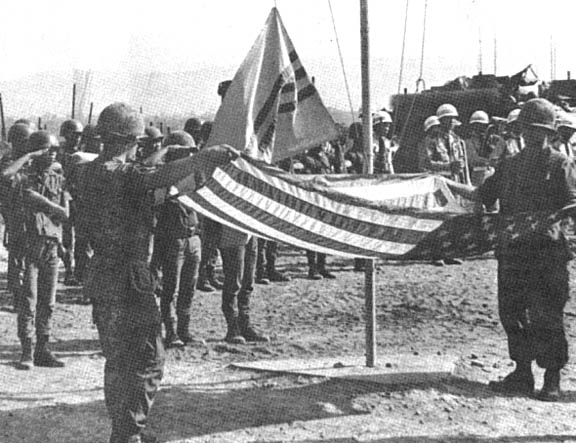 |
| CHANGING HANDS - FSB Hunter is turned over to ARVN soldiers during ceremony in which the American flag was taken down and the Vietnamese flag raised over the ARVNs' new home. (Photo by SGT Bill Oberholzer) |
Night Laager is VC Bogeyman
By SP4 HENRY G. ZUKOWSKI JR.
CU CHI - Triple Deuce mobility with night laager positions is constantly
catching the enemy off guard - stopping enemy resupply and infiltration.
Company B, 2nd Battalion (Mech), 22d Infantry, sets up typical laager
positions throughout the Hau Nghia province area securing Vietnamese villages
and U.S. outposts.
After a long day of riffing through thick underbrush and bamboo, the company
moves to a designated area and drives its tracks into a circular perimeter.
The men begin to build the fighting positions and bunkers. RPG screens are
erected and claymore mines are put out. As an early warning device, trip flares
are set for any enemy trying to infiltrate the perimeter.
In the remaining time before darkness, the troops eat chow, shave and wash
up, and read mail. Men not pulling guard sleep while others begin their night
activities outside the perimeter waiting for NVA or VC near the ambush site.
When light comes again, breakfast is distributed to the troopers. Then all
night-time defenses are taken in and loaded on the APC's. Ready for what
activities the day may bring, the Triple Deuce men mount their tracks and move
out into the brush.
I-Cap Sets Up In Enemy Camp
By SP4 FRANK REZZONICO
BAO TRAI - An I-Cap was conducted within the perimeter of a Viet Cong
basecamp near here by the Civic Action Section of the First Battalion, 27th
Infantry. Luckily the camp's residents were not home at the time.
"One of our medics was walking around the area after we had set up our
equipment when he discovered an opening in the ground near a hedgerow" said
Captain William Goodman of Philadelphia, the OIC of the S-5 section.
"We sent our Kit Carson scout down the opening to see if we had any Hoi
Chanhs down there," Goodman said.
After completion of the I-Cap, the Civic Action Section continued their
search for bunkers and uncovered four more.
"Using grenades, we destroyed the five bunkers we found," said First
Lieutenant Peter Boni of Boston, the OIC of the Sixth Psyops Team.
"We returned to our fire support base and picked up a demo team and returned
to the location and searched for more," said Boni.
Upon returning to the original site the team found seven more bunkers and six
fighting positions. "We found one particular bunker that was 15 by 8 feet with
four feet of overhead cover," Boni said.
Goodman remarked, "We used 15 grenades and 80 pounds of C-4 in blowing the
bunkers."
When all was completed, the men realized where they had set up their I-Cap,
inside the perimeter of an enemy basecamp.
Kit Carson Gets Honda
TAY NINH - A working relationship between Regulars of "D" Company, 3d
Battalion, 22d Infantry, and their Kit Carson Scout has proved rewarding for
both.
The point squad of "D" Company finds security with their scout, Pham Yung
Xuan. Xuan is familiar with the AO and aware of enemy tactics.
For services rendered the Kit Carson Scout was presented with a Honda by the
men of "D" Company for his loyalty.
Regulars Open Club
TAY NINH - A new Enlisted Men's club for the Regulars of 3d Battalion, 22d
Infantry, was opened recently during a ribbon cutting ceremony here.
Commanding Officer Lieutenant Colonel Warren A. Jones and Specialist 4 Stuart
Simonson, Soldier of the Month, cut the ribbon on the new structure.
The Regulars had worked on the club for the past month under the direction of
Sergeant First Class Kaveda Charles who also introduced a new recreation program
in the club.
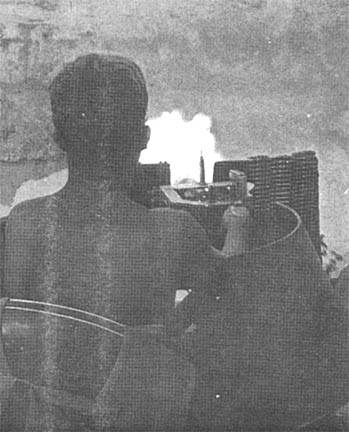 |
OPENING UP - A second platoon mini-gun spits out 4,000 rounds a minute. (Photo by SP4 Henry G. Zukowsky Jr.) |
No More Counting
IPL Tells GI Where He Is
By SP4 GREG DUNCAN
FSB JACKSON - In the past few weeks the men of Bravo Company, 2nd Battalion,
27th Infantry, 25th Infantry Division Wolfhounds seem to have licked a problem
that has plagued the infantry ever since its conception.
Because of an instrument known as the Improved Position Locator, the men of
Bravo company need no longer worry about their location in an unfamiliar or
strange area. Nor do they have to worry about getting to their correct ambush
site even on the darkest of nights.
The Improved Position Locator, an electronic device carried by one man and
worn on the back, has been helping Bravo company keep on the right track during
every type of operation. Automatically computing the distance and direction
that a man has walked, the Improved Position Locator continually provides the
operator with his exact location in relationship to an eight digit coordinate
taken from the point of origin.
"It's really remarkable. We don't have to call back in order to find out our
location, or wander around wasting time looking for reference points," explained
Sergeant John Dumschat of Chesterfield, N.J.
"Every time we've checked it out it has proven to be very accurate and
reliable," added Private First Class Larry Allen of Waitsfield, Vt.
"We think it's just great," said Dumschat. "We only wish we had had it long
before this."
The locator isn't in widespread use yet; USARV is still evaluating it in the
1st Division, the 1st Air Cavalry Division and the 4th Infantry Division as well
as the 25th Division. However there's at least one pack of 'Hounds that seem
already sold.
Page 4-5 TROPIC LIGHTNING NEWS March 2, 1970
Caving in Charlie's Roof
1st Brigade Smashes 169 Enemy Bunkers
TAY NINH - The First Brigade achieved a smashing, crunching success with an
armor-infantry action recently in the Northern Fingers area of Tay Ninh
Province.
According to intelligence reports, the NVA-VC had well-built,
long-established bunker complexes in a six kilometer-long finger of thick jungle
growth. The mission: start at the northern end and perform a massive search of
the area, rendering all bunkers and base camps useless to the enemy.
The team for the job consisted of Alpha, Charlie and Delta Companies, 4/9,
and one platoon of Manchus from Bravo Company. Under operational control to the
mission were two platoons of tanks from 2/34 Armor's Alpha Company.
With the brute force of the tankers smashing a way through the jungle,
Charlie and Delta Companies moved out on line, searching for the suspected
bunkers. They had crashed through only 125 meters of jungle before the first
complex was found.
From that point, it was seemingly an endless job of destroying bunkers with
demolitions or using a combat engineer vehicle to cave them in and plow them
over.
As the search progressed, Alpha Company Manchus acted as a blocking force by
establishing a series of night ambushes at the southern end of the finger. This
action flushed a sizeable enemy force that was engaged by artillery, light fire
teams and air strikes causing the enemy to disperse. Company A, 2/34 Armor,
with the third platoon, Company B, 4/9 Infantry, roared into the contact area in
search of the fleeing enemy. With the tanks using their main guns and
50-caliber machine guns to blow away the jungle, and the infantry furnishing
flank and rear security, the combined arms team rolled relentlessly forward.
Enemy soldiers daring to challenge this force quickly were cut down at point
blank range. By the end of the day, the signs of success took on a material
form: a confirmed body count of 15, three P.O.W.s, four assault rifles, one RPG,
two RPG boosters. three Chi Com grenades, one 45-caliber pistol, AK ammunition,
plus a large amount of rice, clothing and medical equipment.
Meanwhile, the unglamorous task of destroying bunkers went on and on. The
final count was 169 bunkers blown or caved in. Some were large rooms with five
feet of overhead cover.
|
Story and Photos |
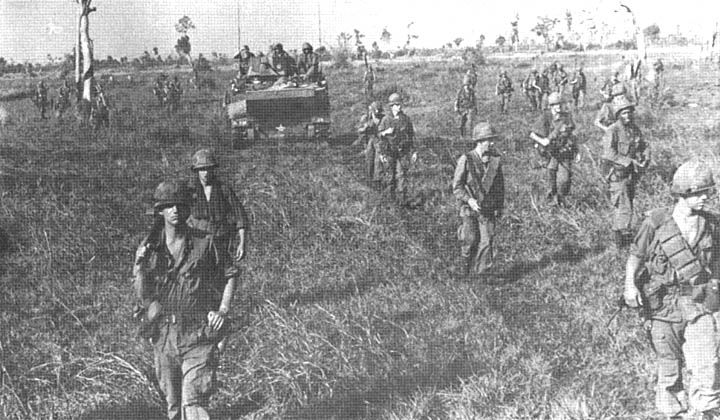 |
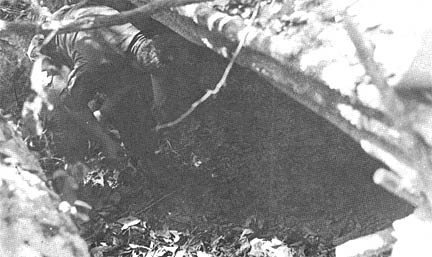 |
|
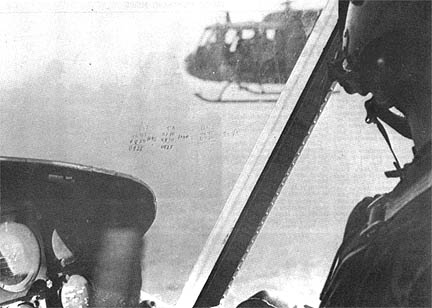 |
|
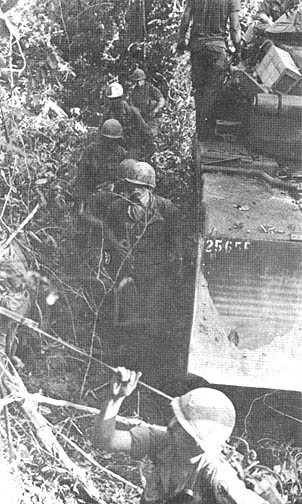 |
|
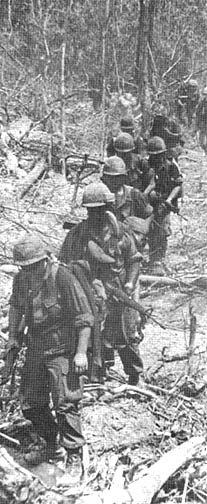 |
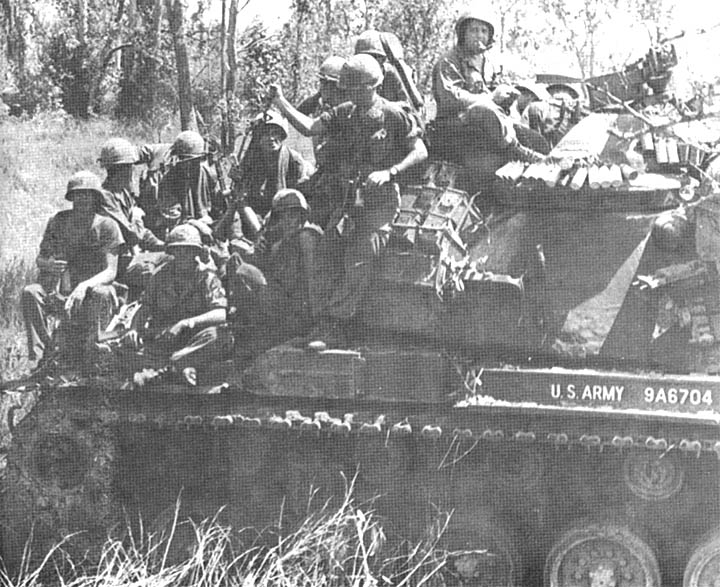 |
Page 6 TROPIC LIGHTNING NEWS March 2, 1970
'Hounds Peek;
No Hide-and-Seek
By SP4 GREG DUNCAN
HEIP HOA - The battlefield version of hide-and-seek is a game that has been
played quite often recently in the vicinity of the Sugar Mill.
It seems that Charlie is particularly fond of this area for hiding the
weapons, munitions and medical supplies that he carries from staging areas
inside Cambodia. What he's not fond of is how this game is being played.
Recently the members of the Reconnaissance platoon of the 2d Battalion, 27th
Infantry, "Wolfhounds," and their Vietnamese counterparts have had considerably
more luck in finding Charles' caches than he has had in hiding them. In the
past few weeks the Recon platoon and members of the Vietnamese 15th
Reconnaissance platoon have uncovered five large caches.
"One we found," said SSG Thomas J. Curren of Wooster, Ohio, "was in a large
bunker complex. We kept searching the hedgerows and found several three to five
man bunkers with all kinds of supplies inside. It looked like a field
hospital."
It was in fact a field hospital capable of accommodating 20-30 personnel and
laden with medical supplies.
Continuous searching of more hedgerows in the next several days turned up
maps of infiltration routes from Cambodia, 39 mortar rounds, 16 rocket-propelled
grenades, eleven 75mm recoilless rifle rounds, 6,000 rounds of AK-47 ammunition
and 86 booby trap grenades.
Speaking of the combined platoons operations and living conditions, 1Lt. Mark
Davis of Port Arthur, Texas said, "We work just like a team."
| 1,000,000 ROUNDS - Honorary connoneer Major General Harris W. Hollis, commanding general of the 25th Infantry Division, pulls the lanyard and sends the one-millionth round fired by the 7th Battalion, 111th Field Artillery speeding towards its target. The round was fired late last month. (Photo by SP4 Dan Neff) |
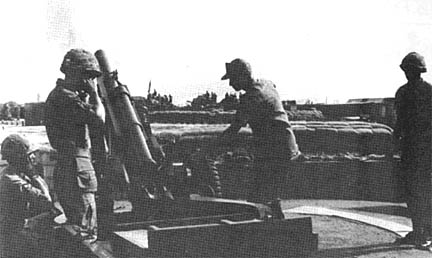 |
PF's Espy Rounds Find Aids Hounds
By SP4 PHIL JACKSON
PHUOC LUU - Tunnels, tall grass and canals have always provided Charlie with
a well-concealed storehouse for his supplies. With the help of Popular Forces
from Phuoc Luu Village, Delta Company of the 2d Battalion, 27th Infantry,
uncovered one well-stashed supply of mortar rounds and AK ammo along the Go Suoi
Canal, one mile northwest of Go Da Hau - depriving the enemy of a plentiful
supply of munitions.
"The PFs from our northern location found 50 cases of AK ammunition the day
before we found ours," said Company Commander Captain J.A. Yurchuck, Columbus,
Ga., "so a couple of the PFs went along to show us how the VC hide their
ammunition."
"We were checking in approximately the same area that the PFs found their
cache," said 3rd platoon leader Second Lieutenant Jerry Collins, Mitchell, S.D.
"We came across a canal and started to check its banks for hidden weapons or the
possibility of tunnel entrances," he continued.
"We started to find mortar rounds hidden under water and along the canal
banks and continued searching until we were sure we had all that was there,"
said Specialist 4 Edward Stanton, Whitestone, N.Y.
Found in the cache were 209 60mm mortar rounds, 52 82mm mortar rounds, nine
120mm mortar rounds and 31,350 rounds of AK ammunition.
Also found were 108 cans of pressure device fuses, four large boxes of mortar
fuses, 56 rounds of 57mm and 75 mm recoilless rifle rounds and five Chicom hand
grenades.
Viets Need Profession Instructors
Here's a chance to break the routine of your job in Vietnam.
John Muehlke, deputy advisor to the Cu Chi District, needs qualified persons
who are interested in teaching Vietnamese High School students and adult
villagers some vocational, professional and language skills.
If you think that you are qualified to teach English, banking, carpentry,
agricultural husbandry, typing, mechanics, dentistry, woodworking or first aid,
contact the DISCOM S5 at Cu Chi 6015 for additional details.
All American teachers will be aided by Vietnamese interpreters.
Ask Sgt. Certain
Dear Sergeant Certain: I am so happy, I had to write to give you the joyful
news: Believe it or not, I just completed a long distance call using the direct
dialing system. And I only had to dial the number 37 times, too. And there
were just four other conversations on the line while I was talking (one of
which, by the way was between two people who kept calling each other
"comrade"). I'm glad, too, because my friends have been saying that I could
drive down to Saigon and back in less time than it would take me to put a call
through. I'm worried, though, that this may have been just a lucky break. Do
you have any hints on using the dial direct method?
A. G. Bell
DEAR AG: We've found this way is the fastest: first, pick up the phone and dial
your number. Then, when nothing happens, shout loudly into the phone, "Oh,
well, I don't think I'll try to get that number any more today." That throws
them off guard. Then, pick up the phone again and dial the operator. Ask for
long distance and say, "Pentagon, please." When the Pentagon answers, ask if
they have any lines open to Saigon or wherever you want to call. Sometimes,
using this method, you can complete a call in as little as four days.
Page 7 TROPIC LIGHTNING NEWS March 2, 1970
In Forward Together Program
Uptight Redlegs Teach Speedy Viet Gunners
By SP4 DOUG SAINSBURY
DUC HUE - One of the most successful methods in the learning process is for
students to roll up their sleeves and get their noses into the subject. This
practical educational method was recently put into effect by the Redlegs of C
Battery, 2d Battalion, 77th Artillery when they conducted training classes on
their M102 howitzers with elements of the 252d Artillery Battalion of the 25th
ARVN Division at this special forces outpost some 20 miles west of Cu Chi.
"We had airmobiled some of our howitzer sections into Duc Hue to support a
four day operation involving elements of the 1st Battalion, 27th Infantry said
Captain John P. Charters, battery commander of C Battery, 2/77. "We felt that
it was an opportune time to continue our efforts under the Dong Tien, or Forward
Together, program."
The ARVN cannoneers at Duc Hue are assigned the task of providing direct
artillery support for combined infantry operations near the Cambodian border.
Their howitzers are the old M101 type and 2/77 has been familiarizing the ARVNs
with the refinements of the new, lightweight M102s.
"At fire support base Chamberlain our battery has conducted frequent classes
on the mechanics of the 102 with other ARVN units for several months, so at Duc
Hue we felt the time was right for some serious practical work," said Charters.
"We experimented during the class at Duc Hue by pairing the ARVNs with us
according to jobs," said Sergeant Zane Green of Quicksburg, Va., howitzer
section chief of C Battery, 2/77. "In other words, we matched an ARVN gunner
with one of our gunners, an ARVN assistant gunner with our assistant gunner and
so on."
A Vietnamese interpreter was on hand to handle any language problems.
Through this matching of personnel, the Up Tight cannoneers were able to
explain in detail the advantages of the M102 over the M101 on an individual
basis.
After a brief period of questions and answers and individual job instruction,
the combined howitzer sections performed several dry runs on fire missions
worked up and called in by the fire direction center. As the practice missions
were phoned to the guns, the ARVN and C Battery Redlegs worked together in
setting the data on the howitzers, but no rounds were fired.
The final exam of the class was a series of actual fire missions designed to
test the ability of the ARVNs in setting the data on the guns quickly and
accurately.
"The ARVNs conducted the real fire missions by themselves every step of the
way, but we watched our students carefully to make sure they had no problems,"
said Sergeant Marlyn Swanson of Morning Sun, Iowa, howitzer section chief.
"I would say the ARVNs earned an "A" on their test during the real fire
missions." said Green. "They had no problem traversing the guns to new
deflections (directions) before firing."
The ARVNs fired several high explosive and white phosphorus marking rounds
during the real missions. The nature of the missions was instruction in the use
of the Q-4 countermortar radar for registrations. Using radar to register the
howitzers is effective because in the past, lack of an air observer has
prevented the ARVN battery from registering. Now, using the radar, they can do
so frequently thus improving the accuracy of their fire.
Specialist 5 Edward Harper of Columbia, S. C., 2/77 liaison at Duc Hue, has
worked closely with the ARVN Redlegs there for the past several months and has
had an opportunity to observe their performance during fire missions on their
own M101s.
"They (the ARVNs) have done a great job with their own howitzers in
supporting the infantry here. Speed is their most obvious asset; they can
really put out the steel," he said.
| DATA FROM FDC - An ARVN soldier observes as RTO of C Battery, 2/77th Artillery demonstrates the correct procedure for receiving and recording firing data called in by fire direction center. (Photo by SP4 Doug Sainsbury) |
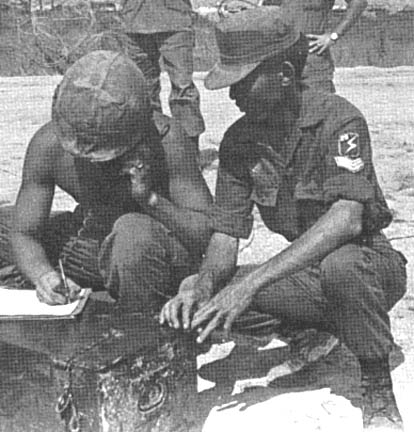 |
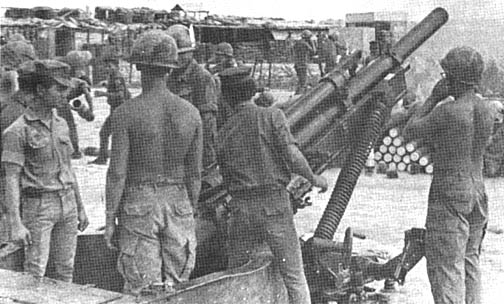 |
FIRE - ARVN cannoneers fire round from C Battery, 2/77th Artillery tube as their Charlie Battery Redlegs teachers look on. (Photo by SP4 Doug Sainsbury) |
Provide Security for Engineers
Regulars Follow Plows, Find Cache
By SP4 DENNIS J. BRIES
CU CHI - Providing roving security for the rome plows plus sweeping behind
the plows for bunkers and tunnels is a heavy job for a mobile unit. Charlie
Company, 2d Battalion (Mech), 22nd Infantry, has taken this task on and is
rolling up a collection of enemy materials.
The Triple Deuce is working with the plows of the 65th Engineer Battalion,
clearing woodlines and hedgerows about 10 miles west of Cu Chi.
A huge chain is dragged over the hedgerows uprooting the bamboo and
uncovering numerous tunnel entrances and bunkers. Troops mounted on APC's
follow behind and check the holes for activity and possible cache sites.
Significant finds have included six POW's in one day, 50,000 Piasters on
another, numerous documents, 15 mailbox-type bombs, six 30 lb anti-tank mines
and several AK rifles. In addition, numerous tunnels, bunkers, mines and
boobytraps have been destroyed by the plows and tracks.
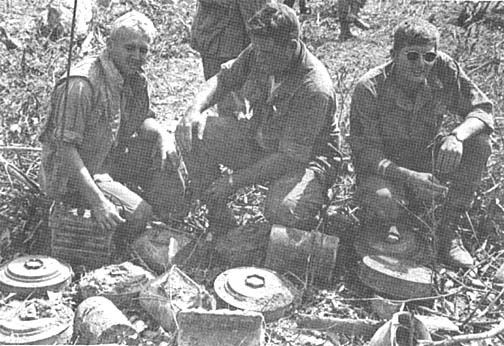 |
BIG FIND - Men of Charlie Company, 2/22, take a closer look at a cache of explosives they found while providing security for the 65th Engineers. (Photo by SP4 Dennis Bries) |
| ONE LESS CACHE - Men of Charlie Company, 2/22, watch as enemy explosives are detonated harmlessly shortly after they were found. (Photo by SP4 Dennis Bries) |
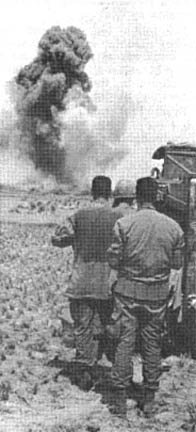 |
Page 8 TROPIC LIGHTNING NEWS March 2, 1970
What's it Like?
Day in the Life of a New Grunt
By SP4 GREG STANMAR
CU CHI - The early morning sun nudges the horizon signaling the beginning of
a new day, one of 365 an infantryman spends in Vietnam.
Private First Class Everen Bravos is new in country - not yet used to little
sleep, the heat and the aggressive mosquitoes.
Bravos spends the two-and-one-half hours before dawn on bunker guard. In his
company, as in many others, two men pull guard at a time to assure alert
defense.
The time is spent talking about feasts that Everen and his buddies have
consumed back in the world, girls, cars and anything that is a part of the life
they left behind.
Much is said about how Everen would straighten out a few things in "this
man's Army" if he were running it.
After a hot breakfast of eggs, bacon and cereal it's time to "saddle up."
Bravos prepares to go on a heliborne operation into a known enemy staging area.
His company's mission is to destroy bunkers and supplies that may be in the
area.
The helicopters arrive at the landing zone without trouble. The company
forms up and begins a systematic search of the area.
As the day weaves on the sun gets hotter. The new warrior is told by the
"short timers" that there are two seasons in Vietnam - hot and dry and hot and
wet.
The company moves three kilometers. Nothing is found. It is time to break
for lunch - "C" rations. Bravos has already learned how to make a field stove.
He cuts a tin can in half, builds a fire inside it and cooks his lunch on the
top.
After lunch the company begins to move again. The point man spots a
geometrical shape on the ground in front of him. He guesses, correctly, that
it's the trap door to a tunnel. The door is opened and the tunnel is checked
out. It contains several enemy weapons, some supplies and a case of
ammunition. They are destroyed and the U.S. unit moves on to the pickup zone.
Suddenly the unit receives sniper fire. The men get their heads down as the
company commander radios for a Cobra gunship.
Moments later the gunship's rockets have silenced the belligerent. The
"slicks" move in, the men board the helicopters and head back to their patrol
base.
Bravos takes a shower and puts on clean clothes. He eats hot chow for
supper. He's in a good mood because he knows his platoon will have its regular
day off tomorrow. He will catch up on his sleep, write letters and relax.
In a letter home he writes "It's a primitive life in many ways. But, when
the day is done and you're cleaned up and fed, you can't help but feel 'Today I
have done my share for that country I miss so much.'"
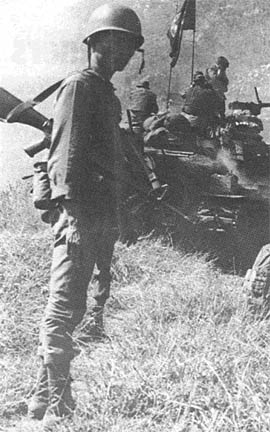 |
A NEW WAR - This Vietnamese soldier is part of a combined operation between ARVNs and U.S. Dreadnaughts. The tanks are softening up the enemy on the hill
before the Vietnamese give the enemy a taste of a new kind of war-combined
operations. (Photo by SGT Danley E. DeLaney)
|
Boosts Spirits
Blow, Bugle, Blow
By SP4 DENNIS J. BRIES
CU CHI - The sound of crisp, clear bugle notes break the morning stillness of
the laager site as Specialist 4 Gary P. Wilson sounds reveille. The bugler
sounds his horn again for evening retreat and taps.
Wilson, 23, Jamaica Plains, Mass., is a radio repairman with Charlie Company,
2d Battalion (Mech), 22d Infantry. He has been blowing the calls since last
October, shortly after his arrival in Charlie Company, Triple Deuce.
Music and instruments are not new for Wilson, who began playing brass
instruments in sixth grade and has continued playing through high school and
college.
In 1967, Wilson graduated from Principia College, Elsah, Ill., with a
Bachelors Degree in Physics. Before entering the service in December, 1968,
Wilson taught high school music, physics and math in Glen Arbor, Mich.
"We have some company spirit now and the bugle adds some musical color," said
Captain Leland Potter, C Company commander.
"I was a little hesitant about playing at first," Wilson said. "But it's a
good way to keep playing. My biggest problem is finding enough time to
practice. I seem to be getting worse because I don't have any notes to review."
Dreadnaughts Blast Mountain And Foe
SGT DANLEY E. DELANEY
FSB BUELL - Rumbling out from the gates of Fire Support Base Buell daily, the
tanks and armored personnel carriers of the Dreadnaughts (2/34th Armor
Battalion) keep enemy infiltration elements under constant pressure by fire.
The tanks' big guns and .50 caliber machine guns can pour out hundreds of
pounds of steel into a large area in a short time to eliminate the enemy's
defenses and his fighting men.
From FSB Buell, where the three companies of Dreadnaughts are tactically
based, it is only a short drive down a dusty, rutted road to the base of Nui Ba
Den.
Keeping tabs on enemy activity on the mountain and preventing reinforcement,
resupply and infiltration, is one of the armormen's missions. They do it by
means of what they call a "fireball." The tanks form up on line and blast away
at the enemy positions for 15 minutes or so, and then infantrymen move past the
tanks up onto the mountain to check results.
Caches of equipment, caves, bunkers, weapons and ammunition left behind by a
hastily fleeing enemy carrying his dead and wounded have been found on several
occasions.
New Chapel Dedicated By Chief of Chaplains
By SGT BILL OBERHOLZER
FSB RAWLINS - Standing alongside other structures at Fire Support Base
Rawlins, Headquarters for the 4th Battalion (Mech) 23rd Infantry, is the
Tomahawk Memorial Chapel.
The building commemorates Lieutenant Colonel Albert Butler, former battalion
commander for the 4/23, who was killed in action last year.
The chapel was designed by Chaplain (Major) John Rakestraw. Construction was
handled by Command Sergeant Major James Gallagher and Sergeant Major Eldon
Johnston.
The chapel was dedicated recently by Major General Francis L. Sampson, the
chief of chaplains for the army, who cut the ribbon officially opening the
chapel.
Many dignitaries have come to FSB Rawlins to view the structure, including
Dr. John R. McLaughlin, general secretary of the Commission on Chaplains in
Church-Related activities, and Bishop Arnold Lewis of the Commission on
Chaplains, representing the Episcopal Church.
There are weekly Catholic and Protestant services held in the chapel. The
chapel is always open and is lighted at night so the tired trooper can worship
or just be alone.
Bravo Comes Home
Dreadnaughts Welcome
'Sis'
TAY NINH - Not everyone in Vietnam gets to welcome home their long lost
sister, but the men of 2nd Battalion, 34th Armor, had the privilege recently
when they welcomed their Bravo Company back from service with the 1st Infantry
Division.
Rolling in from Dau Tieng, the big tanks came down the dusty road to Tay Ninh
base camp. They entered the main gate and parked their tanks in the Holiday
Inn's "parking lot." The tired armormen heaved a sigh - they were "home" again
and glad at the prospect of a relaxing three-day stand down.
After settling down, the men were taken to the Dreadnaughts rear area for a
long-awaited hot meal.
Having stuffed themselves with a good meal they returned to the parking area
to line up their tanks in preparation for the welcome home ceremony.
The tankers sported new jungle fatigues with the "Big Red One" patch on the
right shoulder and the newly-acquired 25th Infantry Division patch on the left.
The men stood proudly as 25th Division commander, Major General Harris W.
Hollis, welcomed them to their new division, and Battalion commander Lieutenant
Colonel William Greenburg welcomed Bravo to the Battalion.
After the welcoming ceremonies, the men enjoyed a steak Bar-B-Q followed by a
floor show at Holiday Inn.
Commenting on returning to the Battalion, Captain Stephen Lang, Bravo Company
commander said, "Returning to the Battalion is a great pleasure and we are
looking forward to working together as an Armor unit."
Fellow men of the Battalion will welcome the men of Bravo company when they
arrive at Fire Support Base Buell, home of the Dreadnaughts near the base of Nui
Ba Den.
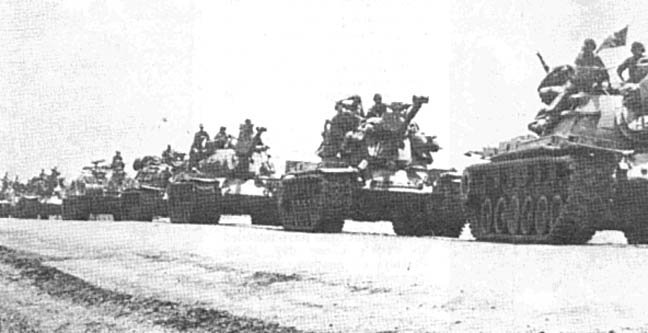 |
| COMING HOME - Bravo Company, 2/34 Armor tanks roll home toward Tay Ninh base camp after a stint with the 1st Infantry Division. (Photo by SGT Wally Baker) |
Thanks to:
Roger Welt, 4th Bn., 23rd Inf., and a Tropic Lightning News correspondent,
for sharing this issue,
Kirk Ramsey, 2nd Bn., 14th Inf. for creating this page.
This page last modified 04-08-2006
©2006 25th Infantry Division Association. All rights reserved